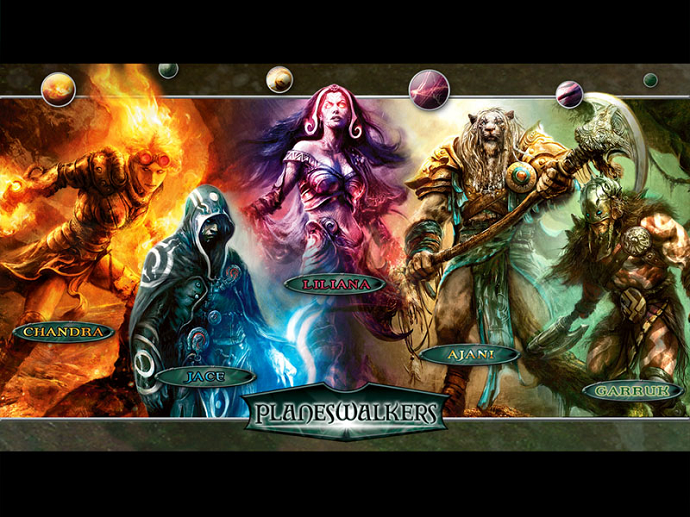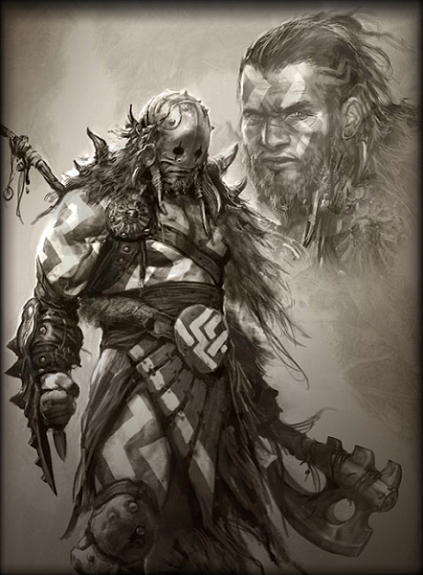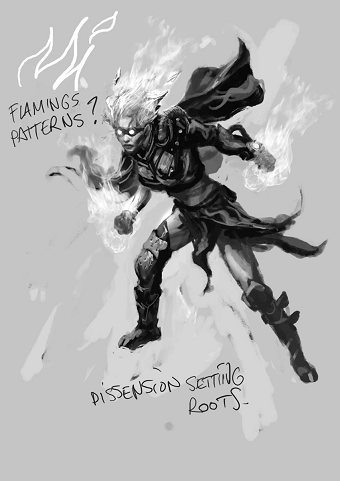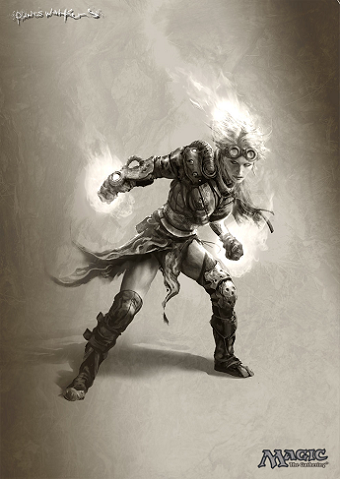French artist Aleksi Briclot has been creating images for Magic: The Gathering since 2005 and is well regarded for his stark science-fiction style. A few years later in 2007, Wizards of the Coast introduced a brand new card type in Magic: planeswalkers. The first five of these powerful Multiverse-traveling mages were introduced in Lorwyn, and they were beautifully illustrated by the man himself.
StarCityGames.com is proud to partner with Aleksi Briclot to deliver these stunning 23.4×33.1-inch lithographs into the hands of his fans!
In celebration of the creation of these lithographs, we arranged to have the artist himself talk about them. I hope you all enjoy my interview with Magic artist Aleksi Briclot.
You have worked on video games, comic covers, magazines, books, novels, trading-card games, role-playing games, and films. How did you first get involved in science-fiction and fantasy art?
Aleksi Briclot: I’ve always tried to diversify my activities and to expand my skills because I’m curious and because I love learning. It was also a good way to avoid boredom just after leaving school (a graphic-design school, not illustration or painting). I was insecure at first. "How will I earn a living with my drawing skills?" So I thought I would get some design work while producing illustrations, comic-book pages, and some concept art.
It could look like the same thing (doing pictures), but each discipline implies different skills and approaches. The process and the goals are not the same at all between working on pages (it’s all about telling a story through different panels), making illustrations (one shot, one opportunity to catch the audience), and concept art (the goal of which is the final game or the movie, not the drawings themselves.)
It’s hard to remember and to give some specific circumstances about why I’m so involved in fantasy and sci-fi. Personal tastes, I would say. It all began at a really early age for me. There was always something inside that grew and then became too big for me to be able to do something else. It was a strong impulse. When I was young, I was very good at school, but I spent all my spare time drawing, painting, sculpting, doing something creative. I was in love with fantastic imagery. I dreamt about doing special make-up and effects for the movie industry. I discovered comic books and RPG illustrations (even if I wasn’t playing). Then tons of new influences and inspirations came. And it was done. That was the beginning of my art journey.
And when dealing in sci-fi, fantasy, or fantastic subjects, there are so many possibilities to create impressive, exciting, disturbing and exotic visions!
You first started working on Magic cards in Betrayers of Kamigawa, where your first pieces were Aura Barbs, Flames of the Firebrand, and Horobi’s Whisper. How did you first get involved with Magic: The Gathering?
Aleksi: I began painting my first Magic: The Gathering card in 2004. At the time, I was working on video games and delivering illustrations for comic books and RPG books. I met a nice guy from the European Hasbro office at a role-playing game convention in France. He had a look at my portfolio, liked my artwork, and sent some samples to the US office. Then they asked me for my first gig on the game. It seems that the Art Director and the people at Wizards of the Coast appreciate what I’ve done, so they’ve carried on asking me for more illustrations.
I’ve done dozens for them, and each time it was about more powerful and important illustrations. They have also commissioned me to illustrate packaging and other visuals used for the communication of the game.
You are most famous in Magic for illustrating eight planeswalkers, including the original Lorwyn five that are the subjects of your new lithograph series on StarCityGames.com. Would you mind telling the story of how you came to paint all five of these key characters?
Aleksi: It’s pretty funny. I must admit that I’m still not a player. Even if I know some parts of the rules and gameplay mechanics, I’ve never played. Shame on me!
I painted the first five Lorwyn planeswalkers in 2007 without knowing how big they would become. It was about doing concepts and painting for six (not five) new characters who were supposed to have a big impact and a huge place in the storyline and the editorial line of the game. They were thought of as really iconic and powerful characters able to travel from one plane to another. And because Magic: The Gathering is based on totally new and fresh settings each year, these new heroes could help make the connection to link all of the Magic worlds through the Multiverse storyline.
So on these first ones, I had to create the look of them. The collaboration with the Art Director, Jeremy Jarvis, was really enjoyable. I could feel that there was something special and bigger about these pieces, but I didn’t know much. I just noticed that the rate for this work was higher than usual and that more people were in the loop. They also asked me to work on concept art first (that means doodles, researches, sketches, and proposals) before working on the final paintings. I received art notes and references, plus bits of storyline, and it was up to me to propose the best visual embodiments for all of them.
I feel lucky that these planeswalkers are still so famous and powerful.

A small story that I just alluded to: I didn’t work on only the first five planeswalkers. I was asked also to work on a sixth one who was named Tezzeret. For this one, they just told me to "do whatever you want and make us some interesting proposal." That’s the kind of art commission that you don’t get very often! So I did the concept art. It seemed that they liked it, and they added him to the storyline.
The character wasn’t released in Lorwyn but was later. And I didn’t paint his first public appearance [Tezzeret the Seeker from Shards of Alara] even though I painted the first concept. When he first shows up in Magic, he’s younger than my version, with brown hair and not yet corrupted. The idea was that my concept was the older version of the character, and it was a really good idea. Fortunately, I was asked to paint my version for a card not much later [Tezzeret, Agent of Bolas from Mirrodin Besieged].
Ajani Goldmane is the lone non-human (or at least vaguely humanoid) of the five original planeswalkers. Was the creation of Ajani any different than the other four?
Aleksi: Not really. He’s anthropomorphic, so it’s all about solving concept issues and character design.
On him I worked from the data that was sent to me, references and parts of backstory. I developed the idea that he had a dead twin brother, so I used the yin and yang symbolism on his weapon with two opposite lion heads. Because the game mechanics revolve around five primary colors, each of my planeswalkers had to be link to one of them. For Ajani, gold and yellow were obviously the colors I had to deal with.
Jace Beleren has arguably become Magic’s main protagonist since his first printing. What was the process of creating Jace like?
Aleksi: He was depicted as a wizard—a dark, powerful, and mysterious one. In our discussion, the art team shared with me tons of inspirations. They spoke about Luke Skywalker in Return of the Jedi. You know, when he comes back more powerful with a black suit.
So a cloak and a hood seemed like a good idea to give him the right sense of mystery. Not showing his entire face on the first visual was also a choice.
I tried to develop some specific graphic patterns for each of these planeswalkers. I was also thinking about the visual look of their magical effects. For Jace, I used some elegant curves and circles with some aggressive spikes close to some cryptic symbols. You can see them on his clothes as well as in his spells.
Liliana Vess is perhaps not coincidentally an anagram of "villainess," which is essentially her role in Magic lore. She is also one of the two female planeswalkers along with Chandra in Lorwyn. What was the genesis of designing Liliana?
Aleksi: The art notes for Liliana were to create a beautiful female character that was much older than she looked. She was thought of as some kind of impressive and mythological queen, powerful and shadowy. I thought about an Egyptian queen. It gave me some feelings about a dramatic pose and atmosphere. It’s a distant inspiration that you can maybe recognize on her headpiece too or perhaps in the small triangles on her clothes. I definitely embraced painting a beautiful woman, and in order to add some clues about how old she is, I used some really slight patterns on her skin. This idea came from the rings that help determine the age of any tree. I played with lots of thin lines on her body, something between scars and ritual tattoos.
Garruk Wildspeaker has a size, shape, and design unlike the other original planeswalkers, and he also is the only one whose face is obscured by a helmet or mask. What was Garruk like to model?
Aleksi: He was the green guy, the barbarian and the savage one. It was obvious that he should be big, tall, and muscular. I used raw materials for his garb: fur, leather, and metal. Putting him on a branch tree helps make a connection with nature and also gives him some sense of agility.

I added some thick orthogonal patterns on him. Strong, raw, and efficient while avoiding delicate drawings. This pattern also appears on his belt. As for his helmet, I chose a kind of metal skull with tusks in order to keep him close to his savage and in some ways animal nature.
Chandra Nalaar, by virtue of her fiery nature, has lighting elements unseen in her Lorwyn cohorts. What was the strategy behind Chandra’s character?
Aleksi: I can’t remember all the details. I know that I used some visual elements from some other previous Magic setting. I’ll just tell you "Ravnica," and maybe you’ll make the connection between her forearm and some other Ravnican outfits. I used burned leather on her and curvy flame-like patterns all around.


The character evolved a little bit later with some new inputs of the Wizards team and other artists. I’ve painted a second version of Chandra since then, which was used in the Duels of Planeswalkers video game, with these changes. Red long hair, and there’s more purple on her.
I had another opportunity to paint Chandra again for another card. And for this one I painted the color sketch live during a Magic tournament in Sweden. Here is a time-lapse video of the making of the card [Chandra’s Phoenix]:
All five of the original planeswalkers are available as lithographs now on StarCityGames.com. Are you excited to see how the pieces hold up as full-size wall art?
Aleksi: Yes I am! I received some samples of StarCityGames.com lithographs, and I didn’t think that they would be so huge. I like the paper too. I love books and prints and feeling the heavy paper.
While I’m working at home or in my studio, I’m mostly alone with my pictures. And because my work is mostly digital, I’m typically facing a computer screen with pixels and not real canvas or paper. I’m struggling with the images, trying to do my best, and then sending them to my clients. Then the cards are released, and I’m not there to look at people’s faces or people’s feelings when they discover them.
Looking at those new prints is an exciting way to rediscover these pictures!
For more news, here is the link to my professional Facebook page.
Thanks Aleksi! And be sure to check out the new Aleksi Briclot lithographs for yourself right here on StarCityGames.com.
Video and Coverage Content Associate and Social Media Artisan for StarCityGames.com
